The marketing technology landscape is expanding rapidly, and it’s becoming cheaper and easier for marketers to run powerful campaigns on their website or other channels.
So, if you want to build a powerful inbound marketing engine, what do you need?
Well, first off, you need a website.
It also helps to have dedicated landing pages, sales pages, splash pages, and lead capture forms. Additionally, you’ll want messaging tools like email, push, or SMS to communicate with your leads and prospects.
All of these tools are invaluable in helping you build powerful inbound marketing systems and predictable revenue.
To help consolidate all of these marketing elements in one place and test new campaigns, there are powerful suites like ClickFunnels that you might try out — but ClickFunnels isn’t for everyone.
Here, we’ll explore 11 alternatives to ClickFunnels that will help you create high-quality campaigns and drive more revenue in 2020 and beyond.
But first — what is ClickFunnels?
What is ClickFunnels?
At its core, ClickFunnels is a company that tries to help you with all of the above. It’s a full suite sales and website funnel building tool, primarily predicated on landing pages and basic marketing automation functionality. The magic is that you can set up pretty clever workflows and funnels without the help of developers.
This means you can move faster, test new campaigns rapidly, and therefore, drive more revenue.
Some of ClickFunnels features include:
- Landing pages
- Sales pages
- Squeeze pages
- Webinar pages (you need to integrate with a 3rd party tool)
- A/B testing functionality
- Email and SMS
- Pre-designed templates
- Automation and sequences
- A/B testing
- Shopping cart
- Full integrated shopping cart platform to sell your products.
- Lead capture forms
- Analytics
- Easily see your revenue, conversions, etc.
- Contacts database
- Lists and segmentation
- Personalization
ClickFunnels also has a raving fan community that loves the company. This makes it easy to find help when you need it.
However, not everyone is a fan and the tool isn’t for everyone.
While it has many features, sometimes you don’t want or need every one of them, or you’d like to use a more powerful tool to accomplish something specific (such as email or landing pages). Additionally, there are often stronger point solutions for a given functionality.
Whatever your reason for seeking an alternative to this popular funnel and landing page building tool, this list should help you with your shopping.
1. HubSpot Marketing Hub
HubSpot’s Marketing Hub includes a myriad of free tools that help marketers do everything from managing your paid ads to collecting leads, building landing pages, and setting up email marketing campaigns.
The coolest part is all of your contacts data is stored in the free CRM, so you can easily access insights and use CRM data to improve and personalize your campaigns.
As an alternative to ClickFunnels, the all-in-one aspect of HubSpot is a big selling point.
Specifically with regards to the landing pages functionality, you’re able to build out beautiful pages — sales pages, squeeze pages, downsell pages, upsells, webinar funnels, etc. — using the simple drag-and-drop editor. There are several landing page templates available to get you started, as well.
Pros
- Easy drag-and-drop builder
- All-in-one platform that plugs into a free CRM
- Get started for free
- A/B testing functionality embedded in most features
- Excellent customer support and documentation
- Embed a calendar to book meetings on your landing page for free
Cons
- Usage limits on free plan
- No custom modules for free
- Not as large a library of templates as other alternatives
Pricing: Starts free and then Starter Tier pricing begins at $50/month.
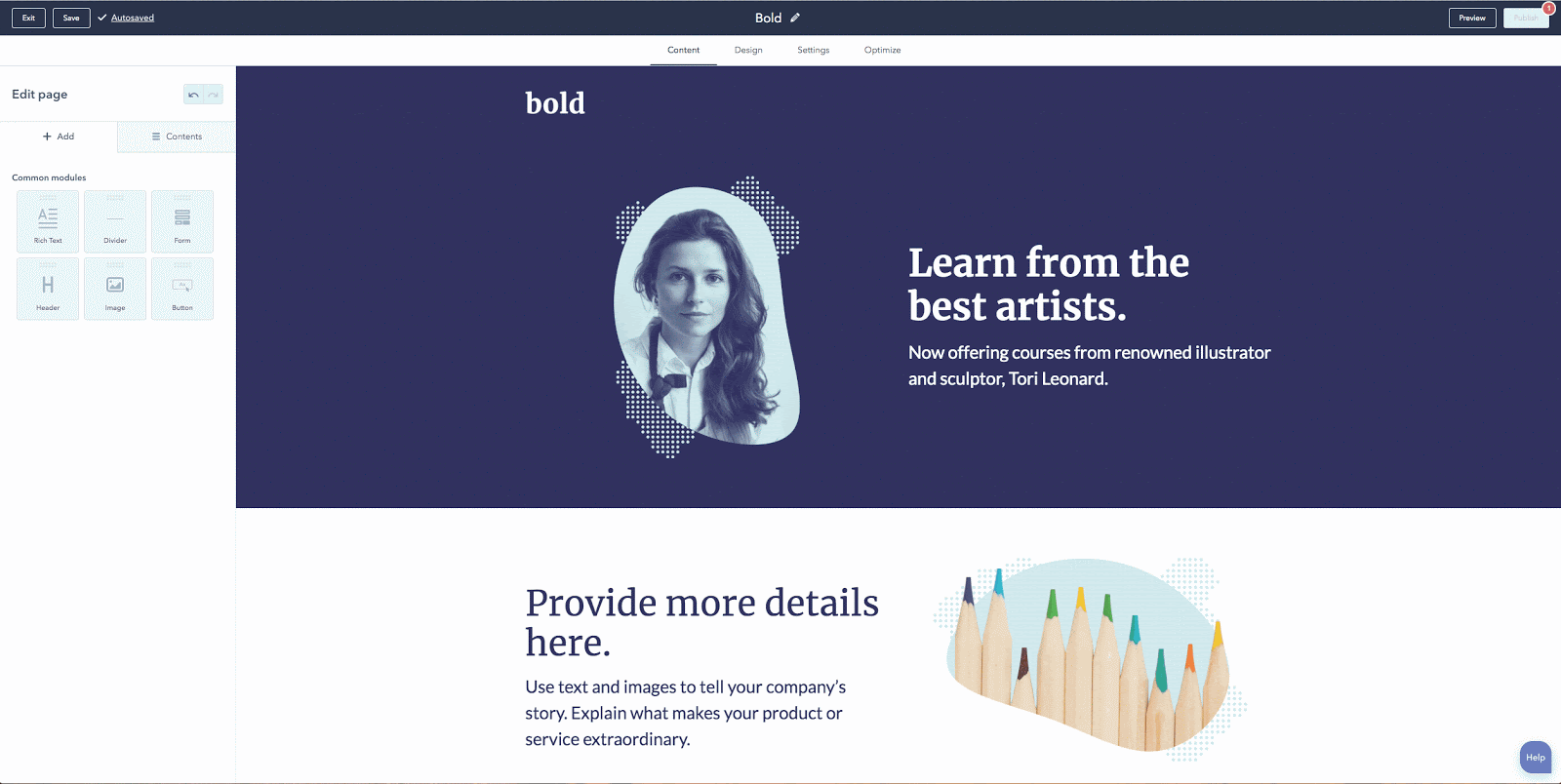
2. Leadpages
Leadpages is a strong contender in the marketing technology world, and it’s an especially popular landing page builder.
Essentially, it allows you to build no code (or low code) websites and landing pages. It also includes handy tools for lead capture and funnel building, such as popup forms, alert bars, and an impressive list of native integrations.
Previously, Leadpages had also owned a marketing automation platform, Drip, though they have since diverged in Leadpages’ recent acquisition. Still, you can easily integrate Drip with Leadpages (or basically whatever marketing automation tool you use).
Pros
- Beautiful drag-and-drop page editors
- Ability to build a full website or landing pages
- Great lead capture tools
- Affordable pricing
Cons
- No email or campaigns functionality
- Lack of robust native analytics reports
- Not the most customizable/complex feature set
Pricing: Starts at $25/month
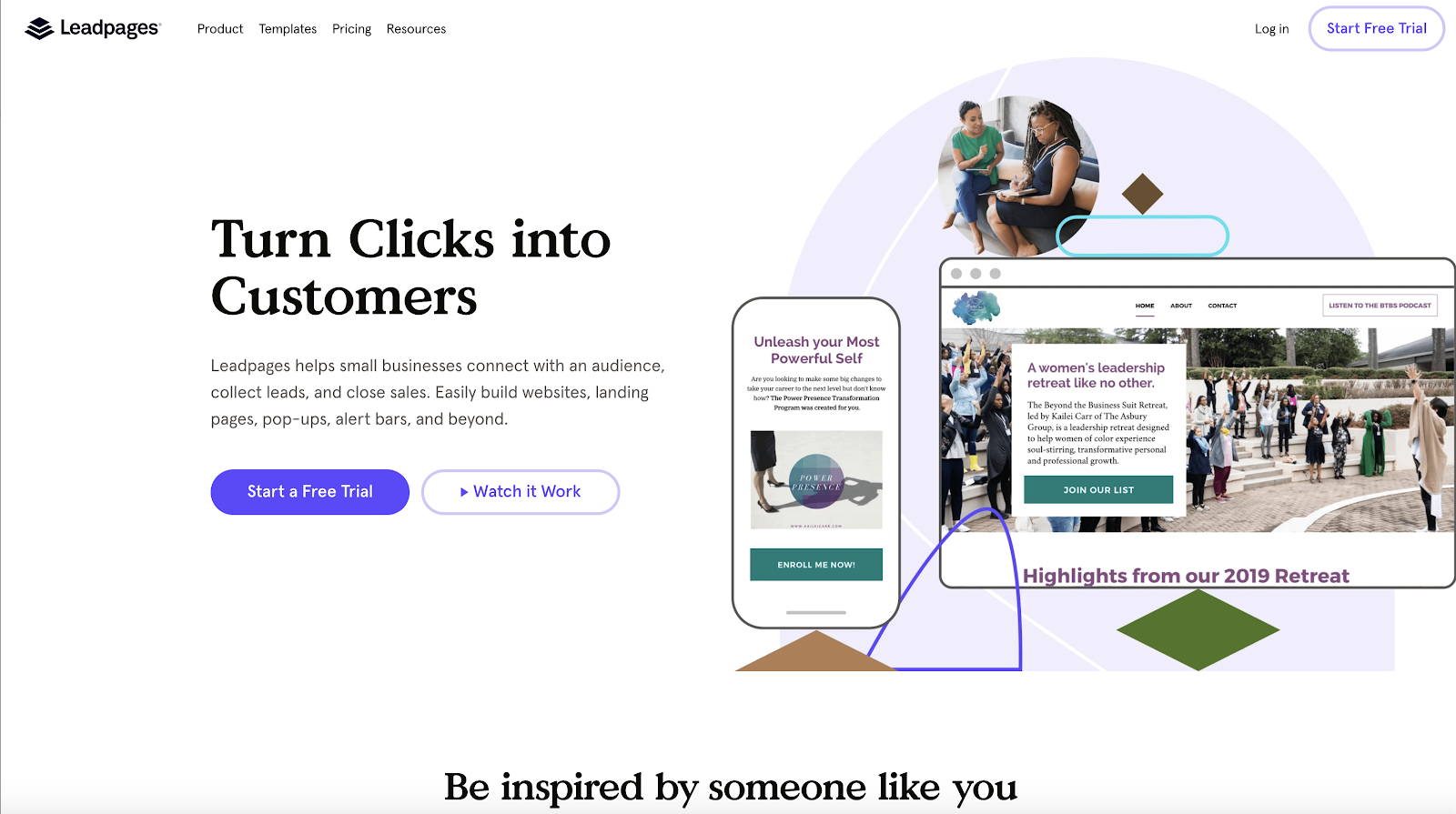
3. Unbounce
Unbounce is one of my favorite landing page builders.
Their landing page editor is easy to use, but the product is also one of the most powerful and flexible I’ve tried out. You’ll be just as satisfied with the tool whether you’re a marketer who can’t code, a marketer who can code, a designer, or a developer. It’s a great product for landing pages at scale.
While landing pages are their bread and butter, they also have some truly great lead capture tools, as well. The pop-up editor is the same WYSIWYG editor that their landing page editor uses, so it’s easy to build beautiful pop-ups (not to mention, they’ve got great templates available, too).
Unbounce has also built a substantial community of users, agencies, and developers. So if you’re looking for help with design, SEO, or PPC campaigns, there are so many agencies that specialize with Unbounce.
One of the coolest features they’ve recently launched is “smart traffic.” This feature uses machine learning to dynamically deliver the right landing page to the right traffic (my guess is through reinforcement learning, but who knows).
Pros
- Easy to use WYSIWYG editor
- Huge community and brand support
- Good customer support
- Mobile-friendly editor
- Strong lead capture tools
- Smart traffic delivers ML-based landing page automation
Cons
- Starting price is a bit more expensive than competitors
- Drag-and-drop functionality can get a little buggy, so your best best is to work with a coder or designer
Pricing: Starts at $80/month
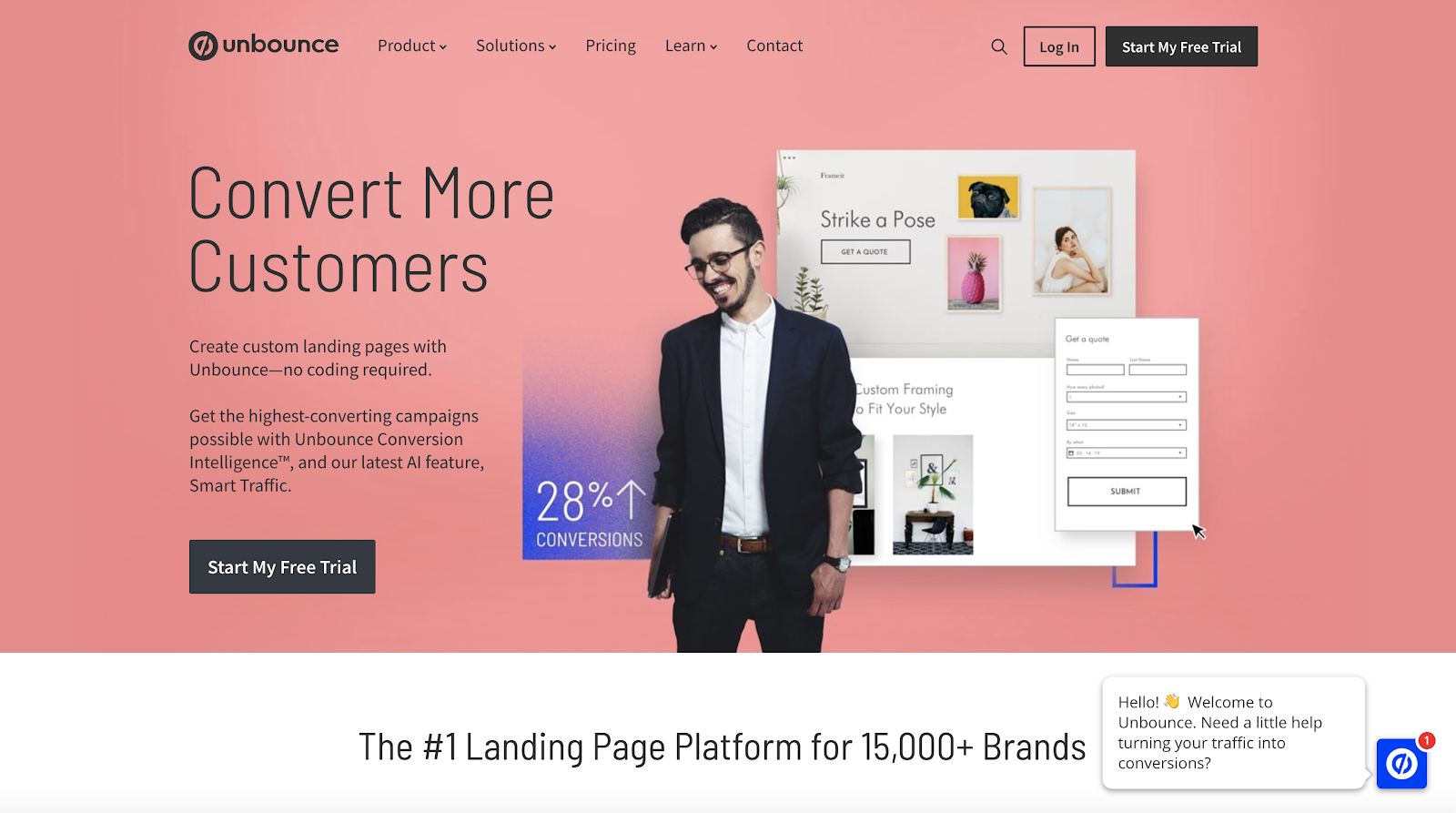
4. Instapage
Instapage is one of the most popular landing page tools on the market.
They’re well-respected among marketers, and offer one of the most scalable solutions when it comes to high-budget growth marketing programs. This includes programmatic personalization, solid experimentation functionality embedded within the product, and AdMaps to visualize the mapping between your pre-click experience on ads and your post-click experience on landing pages.
Underpinning all of this advanced technology is a user-friendly page builder that any marketer can master easily.
Pros
- Powerful feature set great for high scale marketing teams
- AdMap visualizations to link up ad creative to landing pages
- Personalization and experimentation embedded in product
- Strong reputation for lightning fast page speed
Cons
- Higher price point than other alternatives
- Lack of native messaging or campaigns features
Pricing: Starts at $199/month
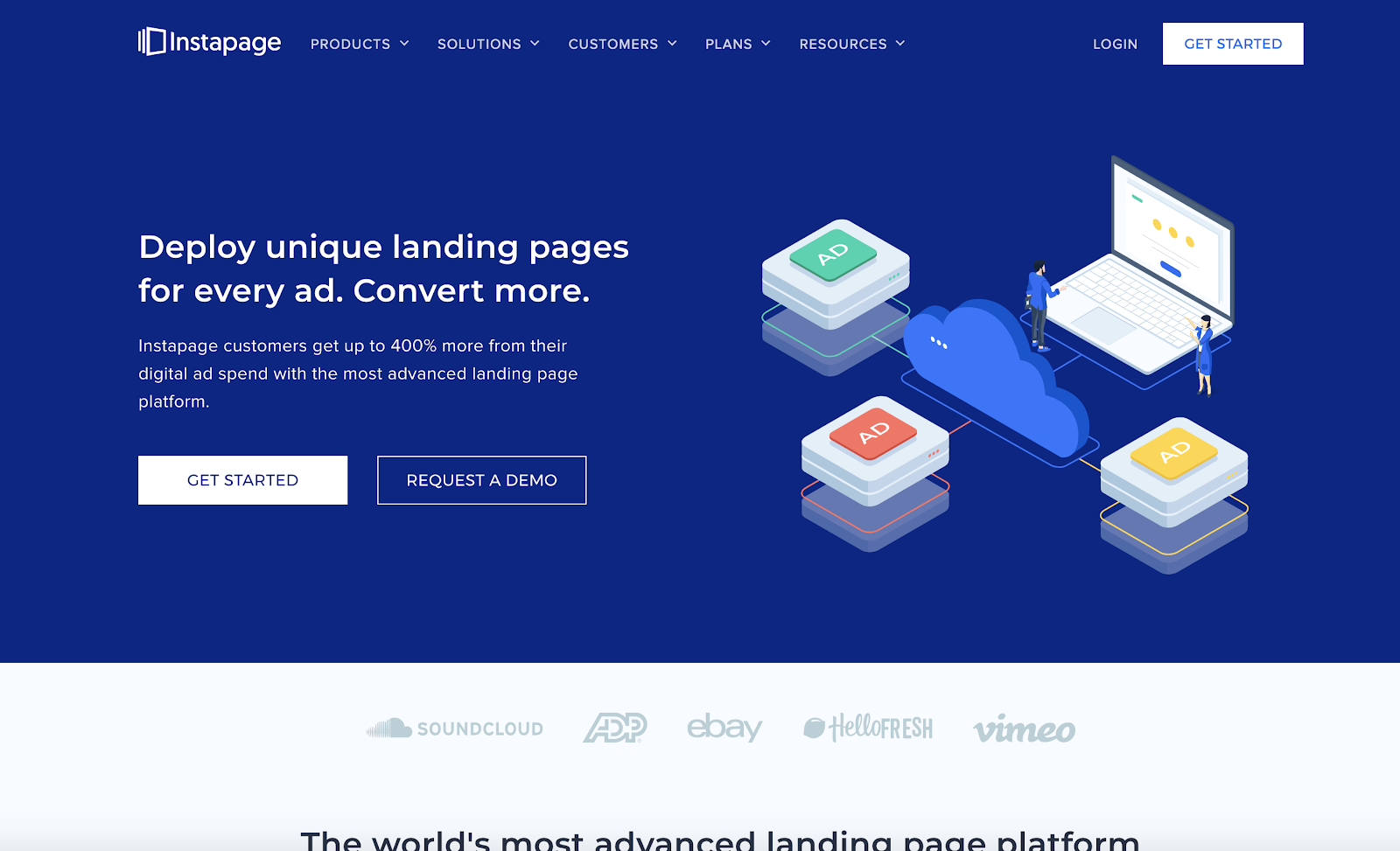
5. Wishpond
Wishpond is an all-in-one marketing platform that might be one of the easiest to use.
First off, they have a stunning array of features. They have ads tools for Instagram, Facebook, and Google, social media promotion tools, email marketing software, lead management, referral programs, landing pages, website pop-ups, cart abandonment triggers, forms, call tracking, and automation.
So if you want the full bucket of features and then some, Wishpond is an impressive platform.
The tools are all built for marketers, so they’re easy to use without the help of a developer.
Pros
- Every feature a marketer could wish for
- Easy-to-use page editor
- Great pop-up building and behavioral triggering
Cons
- Too many features can get confusing and not all are best in breed
- A/B testing functionality is limited
Pricing: Starts at $75/month

6. GetResponse
GetResponse is one of my favorite all-in-one marketing platforms. To be honest, I’ve mainly used them and love them for their email marketing solution. Great deliverability.
But their landing page builder is also impressive. They have some unique features, like robust marketing automation and webinars, as well as some standard tools like forms and pop-ups.
You can easily set up sales funnels or lead magnet funnels, and you can even manage and create social media ads in the platform. Sitting on all of this is a powerful set of analytics tools to visualize exactly how your funnels are performing.
Pros
- Amazing email marketing tool
- Easy-to-use page builder
- Sales and lead magnet funnels
- Integrated webinar functionality
- Affordable entry price
Cons
- Too many features leaves some neglected (lead capture tools aren’t super strong)
Pricing: Starts at $15/month
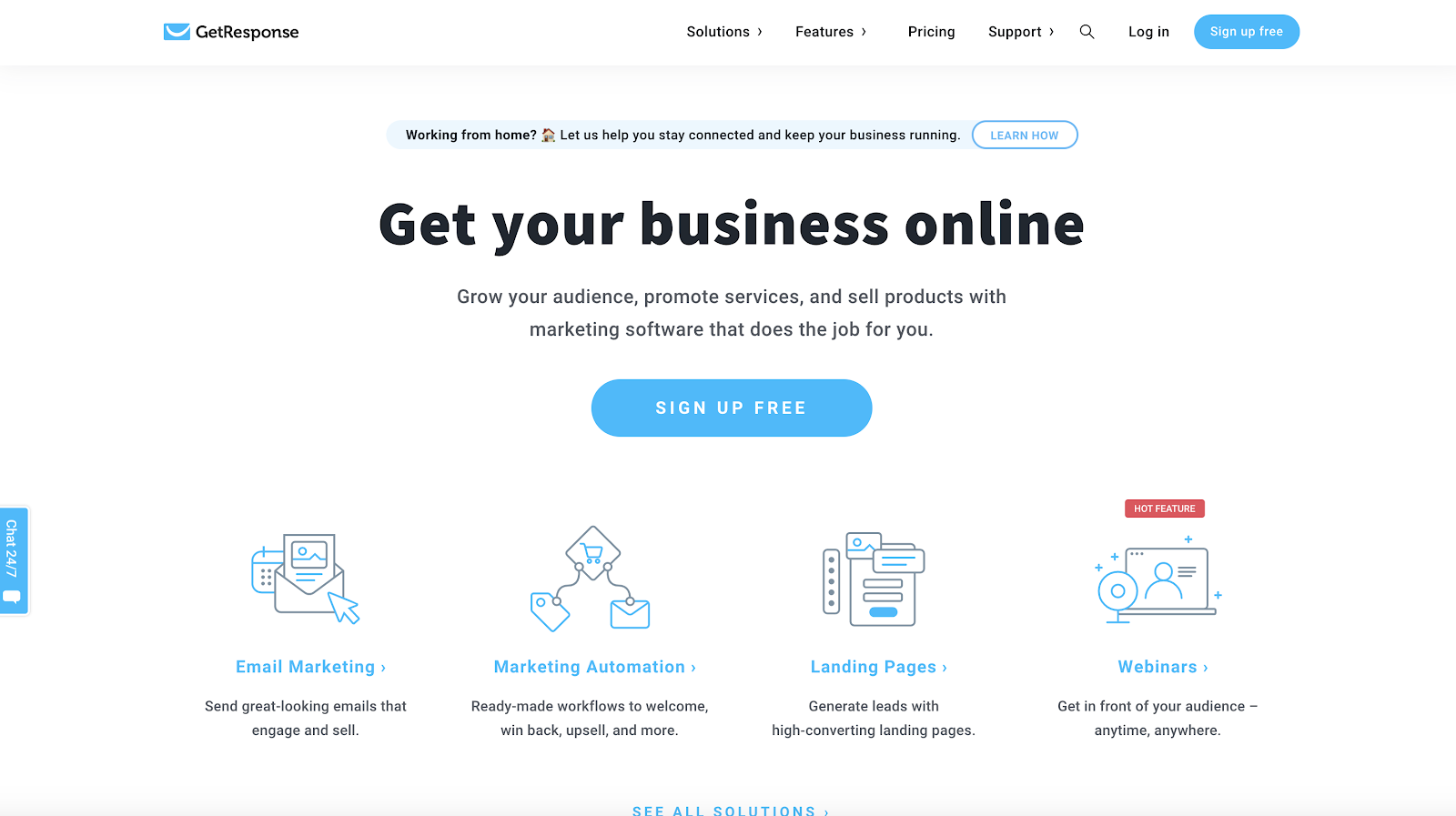
7. Keap
Keap, formerly known as Infusionsoft, is one of the premier marketing automation solutions out there.
Since rebranding and rolling up into Keap, the company has built out a robust platform complete with a CRM as well as various sales features like invoice management, an appointment scheduler, and a sales pipeline manager.
However, most marketers know this company for Infusionsoft, the powerful and long running marketing automation platform. This tool has the whole suite — landing pages, lead capture tools like forms and pop-ups, an email delivery service, automation functionality, and pretty good native analytics reports.
All of this makes it a wonderful solution to manage your sales funnel and online business in general.
Pros
- Powerful and flexible automation features
- Strong community and support network
- Integration with Keap’s CRM and sales tools
Cons
- Can be a difficult learning curve with some features
- More expensive than other tools on this list
Pricing: Starts at $199/month
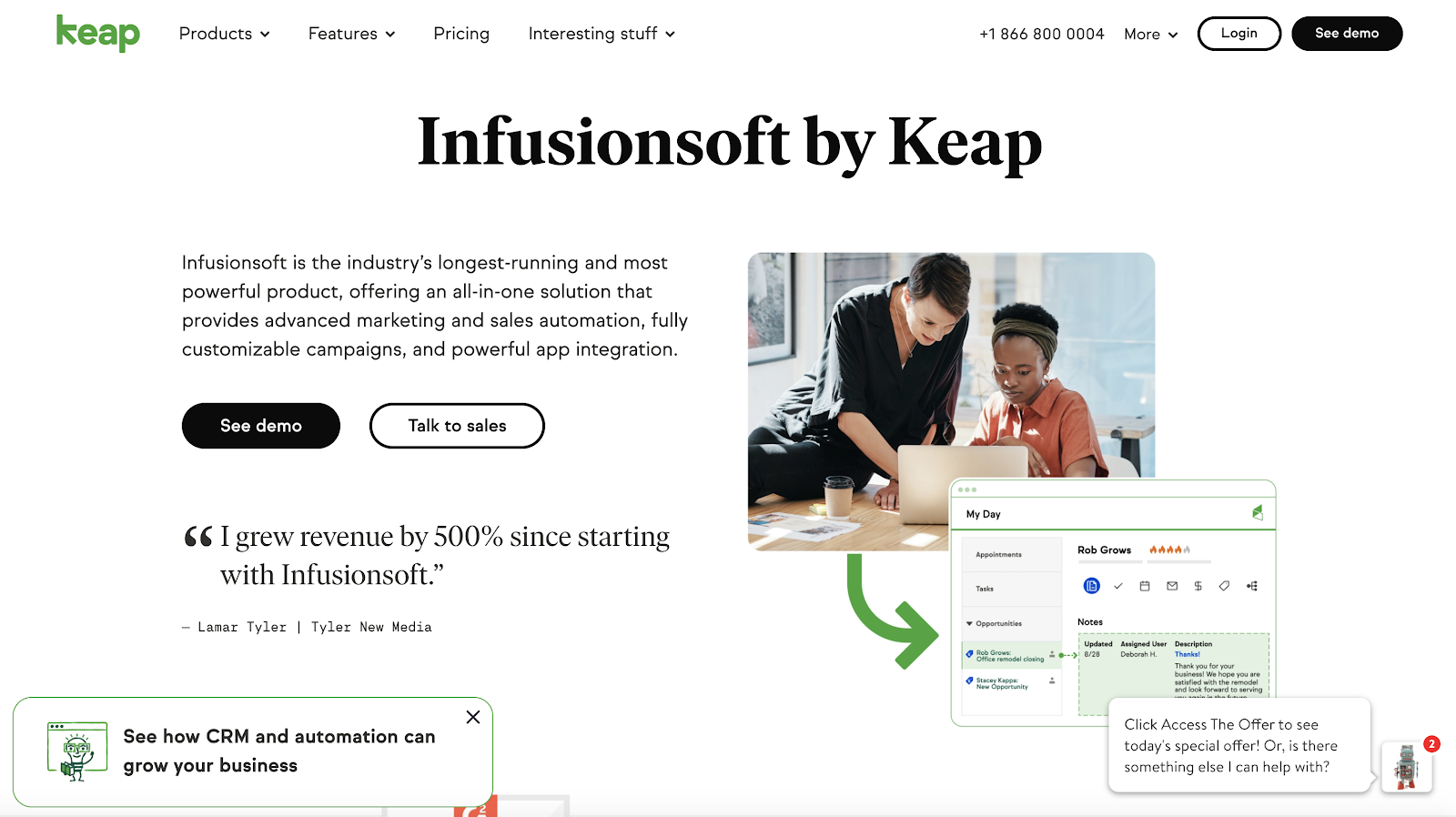
8. Elementor
Elementor is an insanely popular WordPress page builder.
While many ClickFunnels alternatives on this list are full featured marketing platforms, you can get pretty far with WordPress, a page builder like Elementor, and a messaging service (there are many free email marketing tools).
Elementor has over 5 million active installations on WordPress, and it’s easy to see why. It’s an incredibly easy-to-use landing page builder, and any marketer can use it to quickly get started building beautiful pages.
Moreover, it starts out free and is quite affordable even at the paid tiers.
If you need a simple and effective page builder to act as a funnel builder, Elementor is a great option.
Pros
- Easy to use drag-and-drop editor
- Hundreds of premium templates
- Dozens of embedded widgets available
- Plug-and-play with WordPress
- Affordable
Cons
- Only builds pages, so you’ll have to use other tools for messaging and automation
- Sometimes lacks flexibility and customization
Pricing: Starts free, next plan begins at $49/month
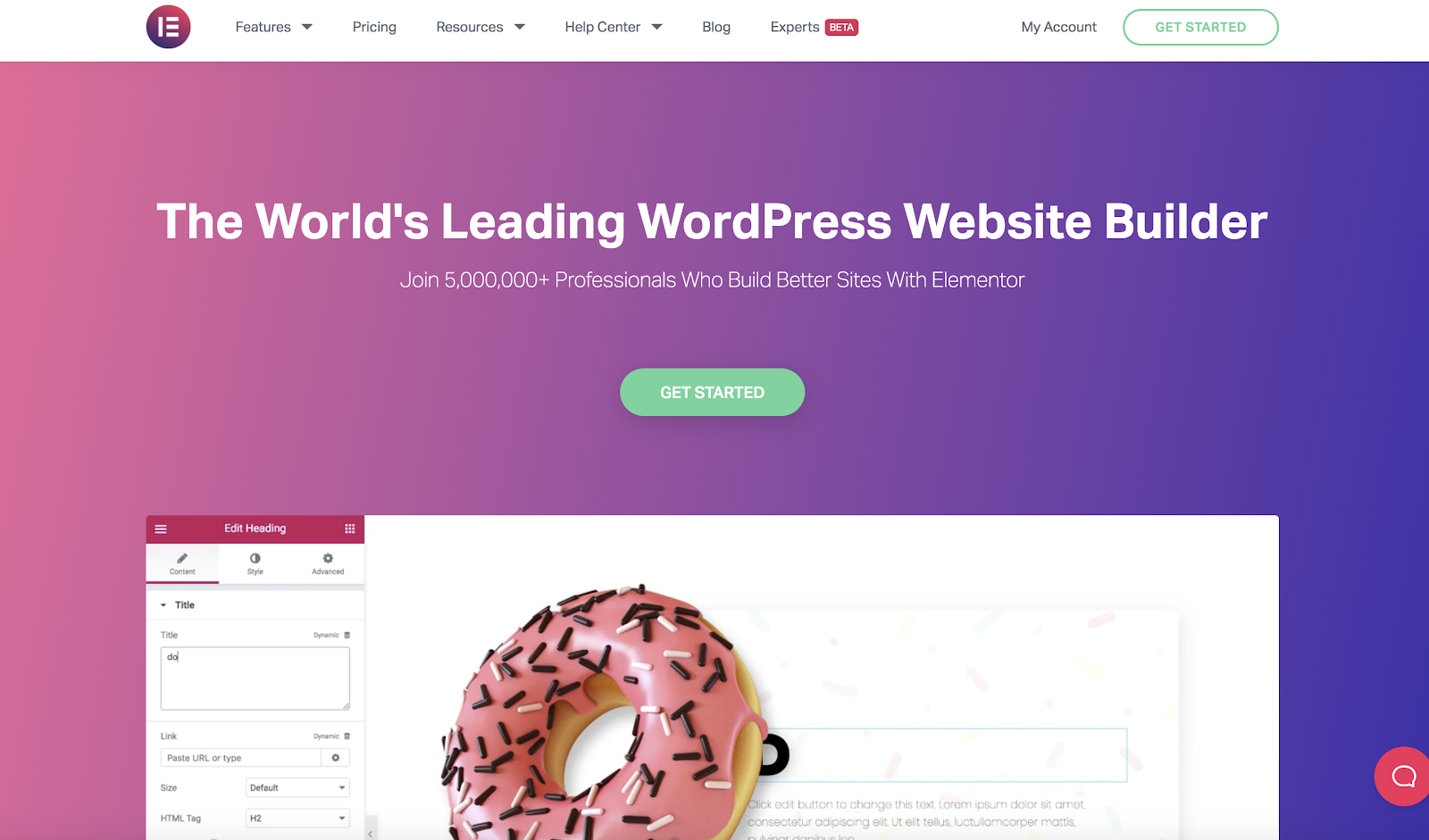
9. Landingi
In my opinion, Landingi is one of the most underrated landing page builders.
First off, it’s easy to use. Additionally, they’ve got a powerful assortment of features, including a mobile-friendly design editor, pop-ups and lead capture functionality that you can use anywhere on your site, a ton of integrations, and optimization and testing capabilities in-app.
Plus, this tool was built as a mobile-first landing page builder. It can often be frustrating designing mobile-friendly pages, so if that’s a concern for you, you should consider this tool.
Finally, if you’re a WordPress user, they have a great WordPress plugin to help get you up and running.
Pros
- Mobile focused, so you can easily design beautiful mobile pages
- Lead capture and pop-up tools
- A/B testing and optimization features
- Easy to use
Cons
- No module building, so it’s not the most scalable solution if you need tons of landing pages
- Not as feature rich as other solutions on this list
Pricing: Starts at $47/month
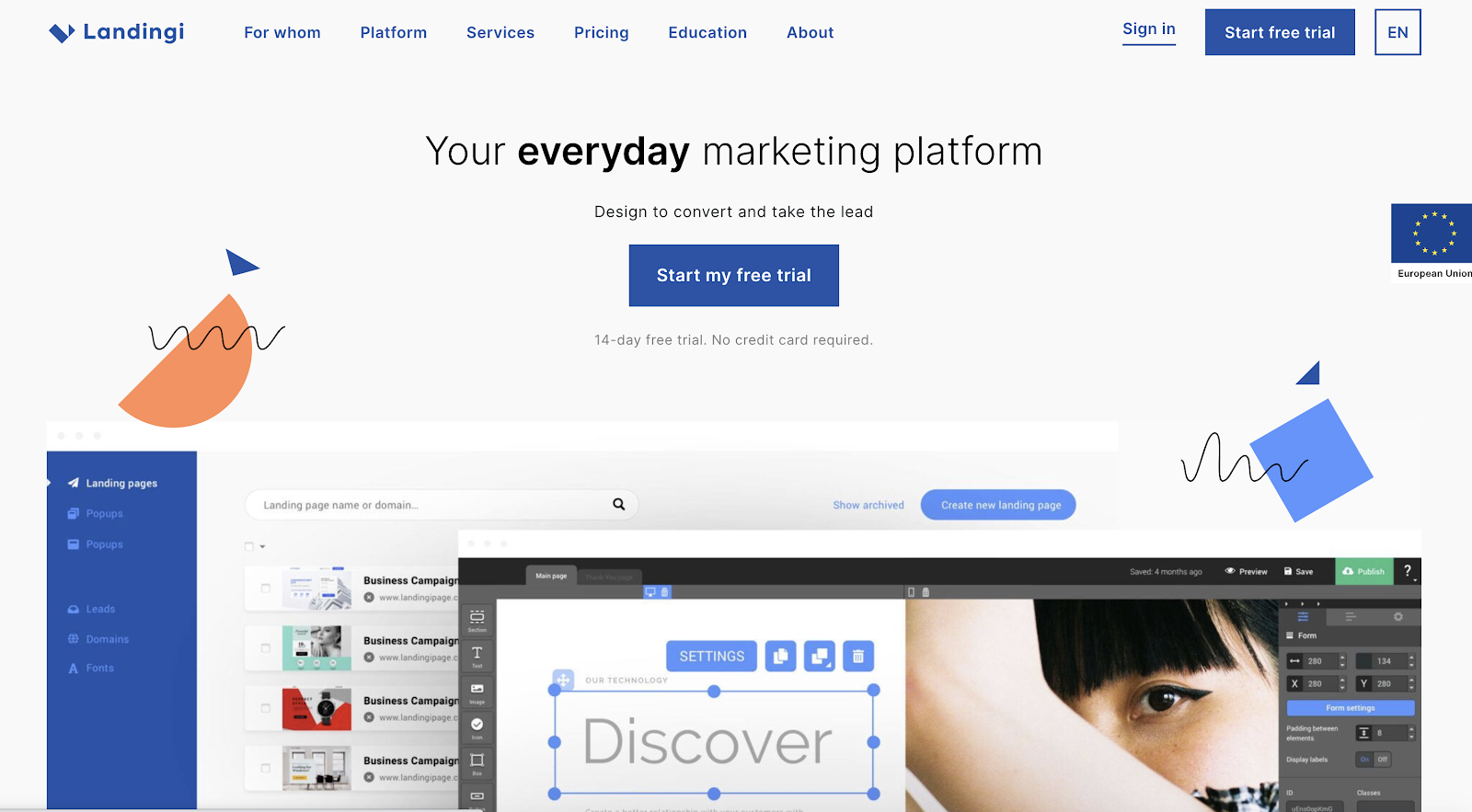
10. Ontraport
Ontraport is another all-in-one marketing solution.
It starts with the Ontraport CRM, where all your data lives. Then you have email and SMS tools to communicate with your prospects and your customers.
And of course, you have a great landing page builder. This also comes with embedded web forms and membership sites, which makes this a wonderful alternative to ClickFunnels.
Pros
- All-in-one feature set that competes head to head with ClickFunnels and Infusionsoft
- Solid page builder
- Good customer support
Cons
- Complains of buggy drag and drop functionality, especially creating emails
- Limitations and lack of flexibility with certain tools, like designing emails or landing pages
Pricing: Starts at $79/month
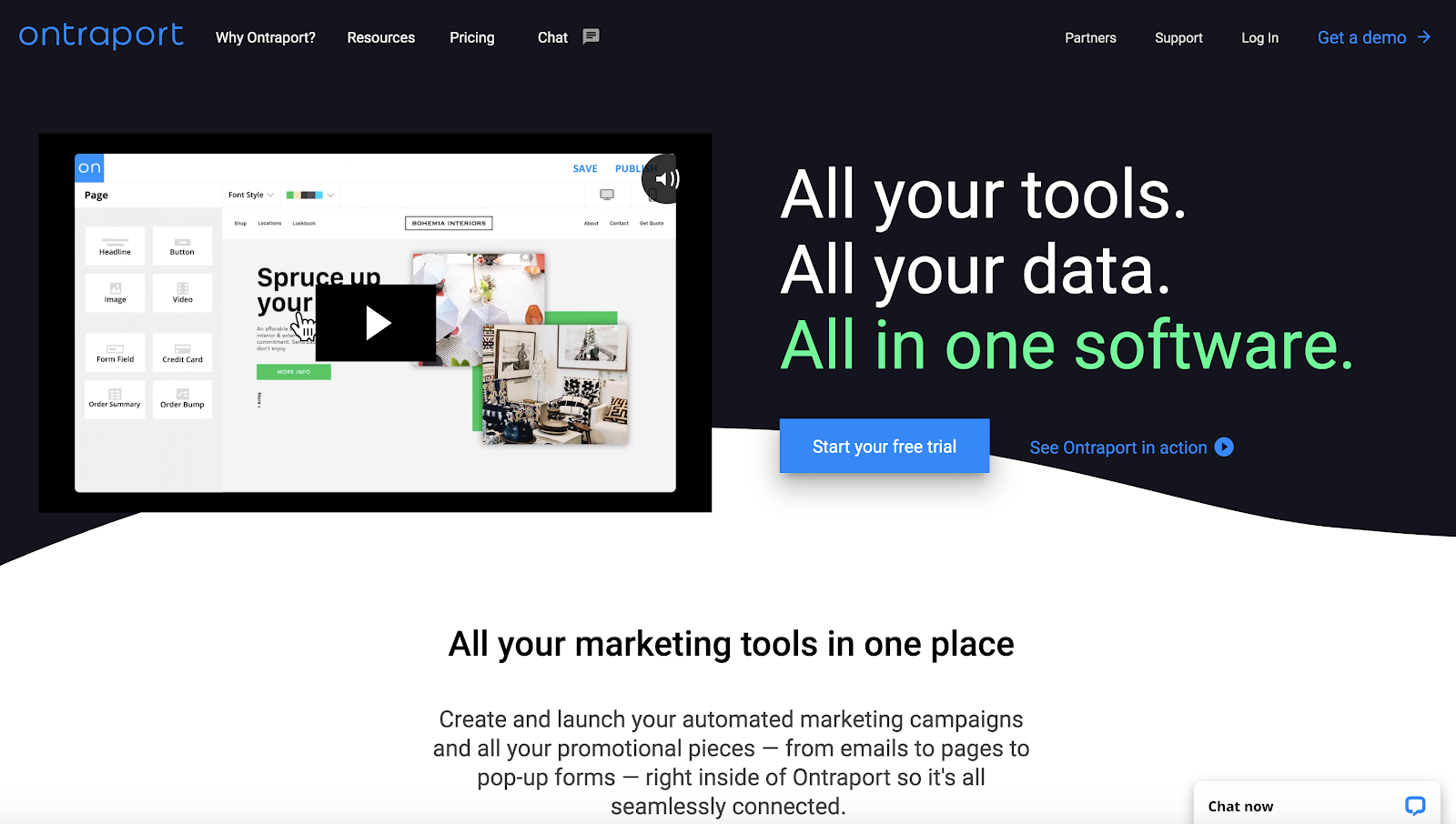
11. Pagewiz
Pagewiz is a dedicated landing page builder — and a powerful one, at that.
They’re a product-led company, putting tons of resources into building a secure, easy-to-use, and flexible page builder. Therefore, if you want best in breed for your landing pages, this is a good bet.
Pagewiz comes replete with every feature you need to build perfect pages — a mobile responsive editor, good A/B testing functionality, video widgets, design features like parallax scrolling, and tons of ready-to-use templates.
You can also integrate with pretty much any other marketing tool you’re currently using.
Pros
- Great product reliability and rich feature set
- Forms and lead capture capabilities
- Mobile responsive editor
- Easy to use WYSIWYG
Many integrations
Cons
- Not as much education, community or support materials for technical issues
- Lack of additional messaging and campaigns features
Pricing: Starts at $29/month
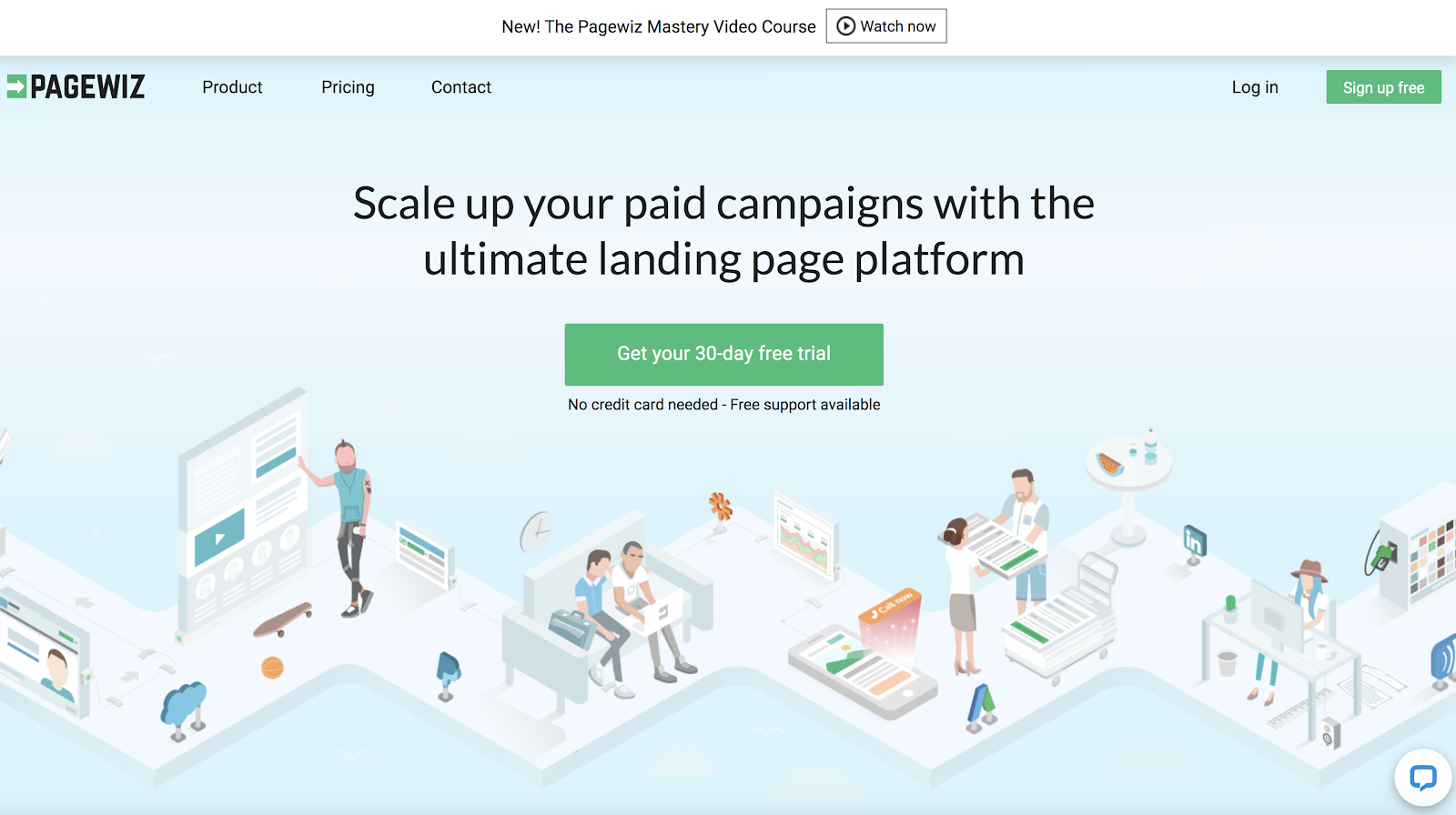
The 5 Best Free ClickFunnels Alternatives
1. HubSpot Marketing Hub
2. Elementor
3. Wix
4. GrooveFunnels
5. BuilderAll
Finding the Best ClickFunnels Alternative
Whatever your reason for seeking a ClickFunnels alternative, know that there are many options on the market now and there will likely be more in the future. The marketing technology landscape continues to expand, not only giving marketers more options, but better and more powerful tools as well.
Some tools on this list serve specific purposes, such as landing pages (Unbounce, Instapage, etc.), but some have all-in-one platforms that have all the features ClickFunnels has, and in some cases, many more.
For an all around effective growth platform, HubSpot’s Marketing Hub is a great solution. You can start out free on many of the tools, including the landing page builder, form builder, CRM, and email marketing platform.
Beyond that, the paid tiers increase the scope and power of what you’re able to accomplish. The sky’s the limit.
![]()
Original Entry: The 11 Best ClickFunnels Alternatives & Competitors in 2020 is shared from https://blog.hubspot.com/marketing/clickfunnels-alternatives via https://blog.hubspot.com/marketing
Check out the original post, The 11 Best ClickFunnels Alternatives & Competitors in 2020 that is shared from https://putyourfamilyfirst.wordpress.com/2020/09/30/the-11-best-clickfunnels-alternatives-competitors-in-2020/ via https://putyourfamilyfirst.wordpress.com
No comments:
Post a Comment